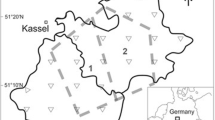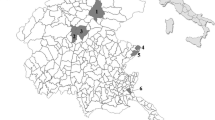Abstract
Ungulates are especially difficult to monitor, and population estimates are challenging to obtain; nevertheless, such information is fundamental for effective management. This is particularly important for expanding species such as roe deer (Capreolus capreolus), whose populations dramatically increased in number and geographic distribution over the last decades. In an attempt to follow population trends and assess species ecology, important methodological advances were recently achieved by combining line or point sampling with geographic information systems (GIS). In this study, we combined density surface modelling (DSM) with line transect survey to predict roe deer density in northeastern Portugal. This was based on modelling pellet group counts as a function of environmental factors while taking into account the probability of detecting pellets and conversion factors to relate pellet density to animal density. We estimated a global density of 3.01 animals/100 ha (95 % CI 0.37–3.51) with a 32.82 % CV. Roe deer densities increased with increasing distance to roads as well as with higher percentage of cover areas and decreased with increasing distance to human populations. This recently developed spatial method can be advantageous to predict density over space through the identification of key factors influencing species abundance. Furthermore, surface maps for subset areas will enable to visually depict abundance distribution of wild populations. This will enable the assessment of areas where ungulate impacts should be minimized, allowing an adaptive management through time.




Similar content being viewed by others
References
Acevedo P, Ruiz-Fons F, Vicente J, Reyes-García AR, Alzaga V, Gortázar C (2008) Estimating red deer abundance in a wide range of management situations in Mediterranean habitats. J Zool 276(1):37–47
Afonso R (2012) O Parque Natural de Montesinho e a promoção do desenvolvimento local. MsC dissertation in Urban and Regional Planning, Aveiro University, Aveiro, Portugal
Akaike H (1974) A new look at the statistical model identification. IEEE Trans Automatic Control 19:716–723
Anderson CK, Nielsen CK, Hester CM, Hubbard RD, Stroud JK, Schauber EM (2012) Comparison of indirect and direct methods of distance sampling for estimating density of white-tailed deer. Wildlife Soc B 37(1):146–154
Apollonio M, Andersen R, Putman R (2010) European ungulates and their management in the 21st century. Cambridge University Press, Cambridge
Barnes RFW, Blom A, Alers MPT, Barnes KL (1995) An estimate of the numbers of forest elephants in Gabon. J Trop Ecol 11(1):27–37
Buckland ST, Goudie IBJ, Borchers DL (2000) Wildlife population assessment: past developments and future directions. Biometrics 56(1):1–12
Buckland ST, Anderson DR, Burnham KP, Laake JL, Borchers DL, Thomas LT (2001) Introduction to distance sampling. Oxford University Press, Oxford
Buckland ST, Anderson DR, Burnham KP, Laake JL, Borchers DL, Thomas L (2004) Advanced distance sampling: estimating abundance of wildlife populations. Chapman & Hall, London
Buckland ST, Burt ML, Rexstad EA, Mellor M, Williams AE, Woodward R (2012) Aerial surveys of seabirds: the advent of digital methods. J Appl Ecol 49:960–967
Burnham KP, Buckland ST, Laake JL, Borchers DL, Marques TA, Bishop JRB, Thomas L (2004) Further topics in distance sampling advanced distance sampling. University Press, Oxford
Burt ML, Paxton CGM (2006) Review of density surface modelling applied to JARPA survey data. Paper SC/D06/J4 presented to the JARPA Review Workshop, Tokyo, p 1–5
Cañadas A, Hammond PS (2006) Model-based abundance estimates for bottlenose dolphins off southern Spain: implications for conservation and management. J Cetacean Res Manag 8(1):13
Carvalho P, Nogueira AJA, Soares AMVM, Fonseca C (2008) Ranging behaviour of translocated roe deer in a Mediterranean habitat: seasonal and altitudinal influences on home range size and patterns of range use. Mammalia 72:89–94
Carvalho JS, Marques TA, Vicente L (2013) Population status of Pan troglodytes verus in Lagoas de Cufada Natural Park, Guinea-Bissau. PLoS One 8(8), e71527
Coulon A, Morellet N, Goulard M, Cargnelutti B, Angibault JM, Hewison AM (2008) Inferring the effects of landscape structure on roe deer (Capreolus capreolus) movements using a step selection function. Landsc Ecol 23(5):603–614
R Development Core Team (2013) R: A language and environment for statistical computing. R Foundation for Statistical Computing. http://www.R-project.org. Accessed 25 Nov 2015
Hastie TJ, Tibshirani RJ (1990) Generalized additive models. Chapman and Hall, London
Hedley SL, Buckland ST (2004) Spatial models for line transect sampling. J Agric Biol Environ Stat 9:181–199
Hedley SL, Buckland ST, Borchers DL (2004) Spatial distance sampling models. In: Advanced distance sampling: estimating abundance of biological populations. Oxford University Press, New York, pp 67-89
Henrys BP (2005) Spatial distance sampling modeling of cetaceans observed from platforms of opportunity. MSc Dissertation, University of St. Andrews, Scotland
Hewison AJ, Vincent JP, Joachim J, Angibault JM, Cargnelutti B, Cibien C (2001) The effects of woodland fragmentation and human activity on roe deer distribution in agricultural landscapes. Can J Zool 79(4):679–689
Hill K, Padwe J, Bejyvagi C, Bepurangi A, Jakugi F, Tykuarangi R, Tykuarangi T (1997) Impact of hunting on large vertebrates in the Mbaracayu reserve, Paraguay. Conserv Biol 11(6):1339–1353
Katsanevakis S (2007) Density surface modelling with line transect sampling as a tool for abundance estimation of marine benthic species: the Pinna nobilis example in a marine lake. Mar Biol 152:77–85
La Morgia V, Calmanti R, Calabrese A, Focardi S (2015) Cost-effective nocturnal distance sampling for landscape monitoring of ungulate populations. Eur J Wildl Res 61(2):285–298
Marques FFC, Buckland ST, Goffin D, Dixon CE, Borchers DL, Mayle BA, Peace AJ (2001) Estimating deer abundance from line transect surveys of dung: sika deer in southern Scotland. J Appl Ecol 38:349–363
Marques TA, Thomas L, Fancy SG, Buckland ST (2007) Improving estimates of bird density using multiple-covariate distance sampling. Auk 124:1229–1243
Miller DL (2014) Distance: a simple way to fit detection functions to distance sampling data and calculate abundance/density for biological populations. R package version 0.8.0. http://CRAN.R-project.org/package=Distance. Accessed 25 Nov 2015
Miller DL, Burt ML, Rexstad EA, Thomas L (2013a) Spatial models for distance sampling data: recent developments and future directions. Methods Ecol Evol 4(11):1001–1010
Miller DL, Rexstad EA, Burt ML, Bravingtion MV, Hedley S (2013b) dsm: Density surface modelling of distance sampling data. R package version 2.1.3. http://CRAN.R-project.org/package=dsm. Accessed 25 Nov 2015
Mitchell B, Rowe JJ, Ratcliffe P, Hinge M (1985) Defecation frequency in roe deer (Capreolus capreolus) in relation to the accumulation rates of faecal deposits. J Zool 207(1):1–7
Mysterud A, Østbye E (1999) Cover as a habitat element for temperate ungulates: effects on habitat selection and demography. Wildl Soc Bull 27(2):385–394
Newey S, Bell M, Enthoven S, Thirgood S (2003) Can distance sampling and dung plots be used to assess the density of mountain hares Lepus timidus? Wildlife Biol 3:185–192
Olivier PI, Ferreira SM, Van Aarde RJ (2009) Dung survey bias and elephant population estimates in southern Mozambique. Afr J Ecol 47(2):202–213
Petersen IK, Mackenzie M, Rexstad EA, Wisz MS, Fox AD (2011) Comparing pre- and post-construction distributions of long-tailed ducks Clangula hyemalis in and around the Nysted offshore wind farm, Denmark : a quasi-designed experiment accounting for imperfect detection, local surface features and autocorrelation. Technical Report 2011–1, CREEM Technical Report, no. 2011-1, University of St Andrews, St Andrews
Plumptre AJ (2000) Monitoring mammal populations with line transect techniques in African forests. J Appl Ecol 37:356–368
Putman R, Watson P, Langbein J (2011) Assessing deer densities and impacts at the appropriate level for management: a review of methodologies for use beyond the site scale. Mamm Rev 41(3):197–219
Rooney TP (2001) Deer impacts on forest ecosystems: a North American perspective. Forestry 74(3):201–208
Rowland MM, Wisdom MJ, Johnson BK, Kie JG (2000) Elk distribution and modeling in relation to roads. J Wildl Manage 64(3):672–684
Schroeder NM, Matteucci SD, Moreno PG, Gregorio P, Ovejero R, Taraborelli P, Carmanchahi PD (2014) Spatial and seasonal dynamic of abundance and distribution of guanaco and livestock: insights from using density surface and null models. PLoS One 9(1), e85960
Scott D, Bacon P, Irvine J (2002) Management of deer in woodlands—literature reviews of woodland design, and techniques for assessing populations and damage. Report to the Deer Commission for Scotland, Centre for Ecology and Hydrology, Aberdeenshire, Scotland
Thirgood SJ (1995) The effects of sex, season and habitat availability on patterns of habitat use by fallow deer (Dama dama). J Zool 235(4):645–659
Thomas L, Buckland ST, Rexstad EA, Laake JL, Strindberg S, Hedley SL, Burnham KP (2010) Distance software: design and analysis of distance sampling surveys for estimating population size. J Appl Ecol 47(1):5–14
Torres RT, Santos JP, Linnell JDC, Virgós E, Fonseca C (2011) Factors affecting roe deer occurrence in a Mediterranean landscape, Northeastern Portugal. Mamm Biol 76:491–497
Torres RT, Virgós E, Santos J, Linnell JD, Fonseca C (2012a) Habitat use by sympatric red and roe deer in a Mediterranean ecosystem. Anim Biol 62:351–366
Torres RT, Virgós E, Panzacchi M, Linnell JDC, Fonseca C (2012b) Life at the edge: roe deer occurrence at the opposite ends of their geographical distribution, Norway and Portugal. Mamm Biol 77:140–146
Torres RT, Santos JP, Fonseca C (2013) Persistence of roe (Capreolus capreolus) and red (Cervus elaphus) deer pellet-groups in a Mediterrenean mosaic landscape. Mamm Biol 9:7–18
Torres RT, Santos JP, Fonseca C (2014) Factors influencing red deer occurrence at the southern edge of their range: a Mediterranean ecosystem. Mamm Biol 79(1):52–57
Torres RT, Miranda J, Carvalho J, Fonseca C (2015) Expansion and current status of roe deer (Capreolus capreolus) at the edge of its distribution. Ann Zool Fennici 52:1–14
Valente AM, Fonseca C, Marques TA, Santos JP, Rodrigues R, Torres RT (2014) Living on the edge: roe deer (Capreolus capreolus) density in the margins of its geographical range. PLoS One 9(2):e88459
Vingada J, Fonseca C, Cancela J, Ferreira J, Eira C (2010) Ungulates and their management in Portugal. European ungulates and their management in the 21st century. Cambridge University Press, Cambridge, pp 392–418
Williams ROB, Hedley SL, Branch TA, Bravington MV, Zerbini AN, Findlay KP (2011) Chilean blue whales as a case study to illustrate methods to estimate abundance and evaluate conservation status of rare species. Conserv Biol 25(3):526–535
Wood SN (2006) Generalized additive models: an introduction with R. Chapman and Hall/CRC, Florida
Acknowledgments
We are grateful to all the people who provided valuable assistance in the field. Likewise, several institutions provided invaluable support: Nature and Forestry Conservation Institute and especially Núcleo Florestal de Bragança. We would like to thank the University of Aveiro (Department of Biology) and FCT/MEC for the financial support to CESAM RU (UID/AMB/50017) through national funds and, where applicable, co-financed by the FEDER, within the PT2020 Partnership Agreement. TAM is partially funded by FCT, Fundação para a Ciência e a Tecnologia, Portugal, through the project UID/MAT/00006/2013.
Funding
This study was co-supported by the University of Aveiro (Department of Biology) and FCT/MEC financially supporting CESAM RU (UID/AMB/50017) through national funds and, where applicable, co-financed by the FEDER, within the PT2020 Partnership Agreement. TAM is partially funded by FCT, Fundação para a Ciência e a Tecnologia, Portugal, through the project UID/MAT/00006/2013. We thank the anonymous reviewers for constructive comments on the manuscript.
Author information
Authors and Affiliations
Corresponding author
Ethics declarations
This article does not contain any studies with human participants or animals performed by any of the authors.
Conflict of interest
The authors declare that they have no conflict of interest.
Rights and permissions
About this article
Cite this article
Valente, A.M., Marques, T.A., Fonseca, C. et al. A new insight for monitoring ungulates: density surface modelling of roe deer in a Mediterranean habitat. Eur J Wildl Res 62, 577–587 (2016). https://doi.org/10.1007/s10344-016-1030-0
Received:
Revised:
Accepted:
Published:
Issue Date:
DOI: https://doi.org/10.1007/s10344-016-1030-0




